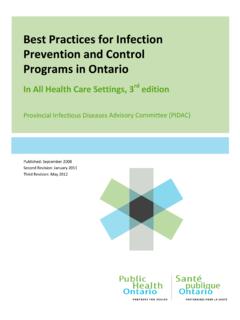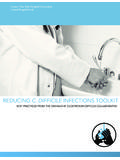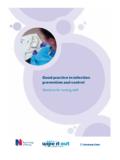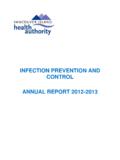Transcription of THE NATIONAL INFECTION PREVENTION AND …
1 THE NATIONAL INFECTION PREVENTION AND control policy & STRATEGY April 2007 Preamble Many countries across the world are currently grappling with making health care safer for patients through carefully designed systems and methods of care that reduce risks to patients. This need to redesign and strengthen existing systems and implement evidence-based methods has been fanned by the sudden emergence and re-emergence of infectious diseases as well as the gradual development of drug resistance. These threats make it that more important that health care associated infections acquired in health facilities are prevented or effectively controlled when it does occur. In South Africa these threats have the proven ability to undermine the significant health care advances we have made in the past decade.
2 In our own quest to also improve the safety of health services and thus align ourselves in part with the international challenges set by the World Health Organization s Global Patient Safety drive, a NATIONAL INFECTION PREVENTION and control policy and accompanying strategy have been developed and is hereby presented to all health care personnel in the country. I believe this policy and strategy serve as a sound NATIONAL framework for improving the management of health care associated infections at NATIONAL , provincial, district and facility level. The Department of Health is committed to providing a higher quality of life for all the people of South Africa by preventing health care associated infections . The goal of minimizing health care associated infections in our health care facilities can only be realized through commitment and rigorous execution of roles and responsibilities by our health care workers and managers at all levels.
3 I therefore challenge all health care personnel to consciously be guided by the NATIONAL framework and to do everything in their power to protect health care users from acquiring health care associated infections . MR T D MSELEKU DIRECTOR-GENERAL: HEALTH Acknowledgements Developing the NATIONAL INFECTION PREVENTION and control policy and its accompanying strategy was no easy task when considering the amount of specific technical expertise required for developing a policy and strategy of this distinctive nature. Thus, it took several months to research, write, and extensively consult and debate. Many public officials from all nine provinces, academics from various tertiary training institutions and knowledgeable people from the private sector contributed at various stages to this process of policy development. As part of the process, three special departmental events come to mind in this regard.
4 The INFECTION PREVENTION and control Workshop in September 2005, the Ministerial Workshop for Public Hospital Chief Executive Officers in October 2005 and the NATIONAL Quality Month Seminar on INFECTION PREVENTION and control in November 2005 created a platform for active participation and debate. The Department of Health would like to express its sincere appreciation to each and everyone who in her or his own way made a contribution at these events and thereafter. Being well aware that mentioning by name those that have contributed always carries the risk of also unknowingly excluding important names, the Department of Health would still like to take the liberty in acknowledging certain individuals contributions. Their contributions have highly enriched the process and thus the final product. A special word of appreciation is extended to professors A. Duse, S. Mehtar, H. Mzileni, E. Blignaut and S.
5 Whittaker, doctors F. Hyera and R. Mulumba, Ms L. Ziady, Ms L. Devinish and Ms J. Soester. A special word of thanks is also extended to our colleagues who made their contributions as heads of the provincial INFECTION PREVENTION and control units and as heads of the provincial Quality Assurance units. The balance brought along by them in terms of the do-ability of the policy and strategy should not be underestimated. The Department of Health wishes to also acknowledge the generosity of the Italian Corporation who contributed to the development of the strategy. Preamble Many countries across the world are currently grappling with making health care safer for patients through carefully designed systems and methods of care that reduce risks to patients. This need to redesign and strengthen existing systems and implement evidence-based methods has been fanned by the sudden emergence and re-emergence of infectious diseases as well as the gradual development of drug resistance.
6 These threats make it that more important that health care associated infections acquired in health facilities are prevented or effectively controlled when it does occur. In South Africa these threats have the proven ability to undermine the significant health care advances we have made in the past decade. In our own quest to also improve the safety of health services and thus align ourselves in part with the international challenges set by the World Health Organization s Global Patient Safety drive, a NATIONAL INFECTION PREVENTION and control policy and accompanying strategy have been developed and is hereby presented to all health care personnel in the country. I believe this policy and strategy serve as a sound NATIONAL framework for improving the management of health care associated infections at NATIONAL , provincial, district and facility level. The Department of Health is committed to providing a higher quality of life for all the people of South Africa by preventing health care associated infections .
7 The goal of minimizing health care associated infections in our health care facilities can only be realized through commitment and rigorous execution of roles and responsibilities by our health care workers and managers at all levels. I therefore challenge all health care personnel to consciously be guided by the NATIONAL framework and to do everything in their power to protect health care users from acquiring health care associated infections . MR T D MSELEKU DIRECTOR-GENERAL: HEALTH Acknowledgements Developing the NATIONAL INFECTION PREVENTION and control policy and its accompanying strategy was no easy task when considering the amount of specific technical expertise required for developing a policy and strategy of this distinctive nature. Thus, it took several months to research, write, and extensively consult and debate.
8 Many public officials from all nine provinces, academics from various tertiary training institutions and knowledgeable people from the private sector contributed at various stages to this process of policy development. As part of the process, three special departmental events come to mind in this regard. The INFECTION PREVENTION and control Workshop in September 2005, the Ministerial Workshop for Public Hospital Chief Executive Officers in October 2005 and the NATIONAL Quality Month Seminar on INFECTION PREVENTION and control in November 2005 created a platform for active participation and debate. The Department of Health would like to express its sincere appreciation to each and everyone who in her or his own way made a contribution at these events and thereafter. Being well aware that mentioning by name those that have contributed always carries the risk of also unknowingly excluding important names, the Department of Health would still like to take the liberty in acknowledging certain individuals contributions.
9 Their contributions have highly enriched the process and thus the final product. A special word of appreciation is extended to professors A. Duse, S. Mehtar, H. Mzileni, E. Blignaut and S. Whittaker, doctors F. Hyera and R. Mulumba, Ms L. Ziady, Ms L. Devinish and Ms J. Soester. A special word of thanks is also extended to our colleagues who made their contributions as heads of the provincial INFECTION PREVENTION and control units and as heads of the provincial Quality Assurance units. The balance brought along by them in terms of the do-ability of the policy and strategy should not be underestimated. The Department of Health wishes to also acknowledge the generosity of the Italian Corporation who contributed to the development of the strategy. TABLE OF CONTENTSSECTION 1: THE NATIONAL INFECTION PREVENTION AND control policy PAGE1.
10 INTRODUCTION 6 2. SCOPE 6 3. PURPOSE OF THE policy 6 4. OBJECTIVES 7 5. LEGAL AND REGULATORY FRAMEWORK 7 6. NON-COMPLIANCE 7 7. DEFINITIONS 8 8. PRINCIPLES 9 9. CONTINUITY OF CARE 9 10. GOVERNANCE 10 11. MONITORING AND EVALUATION 11 12. QUALITY IMPROVEMENT 13 13. PARTNERSHIPS 14 14. EMPLOYEE HEALTH MANAGEMENT 15 15. STANDARDS 15 16. INFECTION PREVENTION AND control ROLES/ RESPONSIBILITIES 16 SECTION 2: THE NATIONAL INFECTION PREVENTION AND control STRATEGY PAGE1. INTRODUCTION 27 2. PURPOSE OF THE STRATEGIC PLAN 28 3. SITUATIONAL ANALYSIS 28 4. STRATEGIC AREAS OF ACTION 31 AREA 1: PROMOTING EARLY DETECTION OF infections THROUGH SURVEILLANCE AND MONITORING ACTION AREA 2: ADDRESSING HEALTH CARE WORKER NEEDS AND REQUIREMENTS; EDUCATION FOR DOCTORS, NURSES AND ANCILLARY HEALTH CARE WORKERS 32 ACTION AREA 3: REDUCING RISK THROUGH IMPLEMENTATION OF GUIDELINES FOR INFECTION PREVENTION AND control 32 ACTION AREA 4: REDUCING RESERVOIRS OF INFECTION 33 ACTION AREA 5: BEST USE OF ANTIBIOTICS 34 ACTION AREA 6: MANAGEMENT AND ORGANISATIO 34 ACTION AREA 7: RESEARCH AND DEVELOPMENT 35 5.







